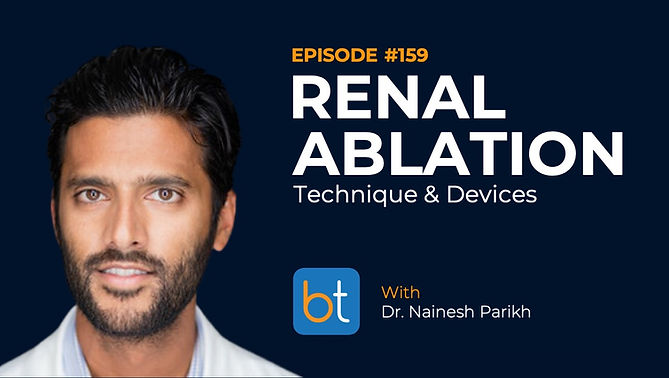BackTable / VI / Podcast / Episode #159
Renal Ablation Technique & Devices
with Dr. Nainesh Parikh
Dr. Nainesh Parikh from Moffitt Cancer Center discusses his approach to ablation of small renal masses, including workup, technique, and device selection. He also tells us why he has the best job ever!
This podcast is supported by:
Be part of the conversation. Put your sponsored messaging on this episode. Learn how.

BackTable, LLC (Producer). (2021, October 11). Ep. 159 – Renal Ablation Technique & Devices [Audio podcast]. Retrieved from https://www.backtable.com
Stay Up To Date
Follow:
Subscribe:
Sign Up:
Podcast Contributors
Synopsis
In this episode, Dr. Nainesh Parikh and our host Dr. Michael Barraza discuss tips for renal ablation and multispecialty care for kidney cancers.
First, they delve into the decision-making process for choosing between cryoablation and microwave ablation. Dr. Parikh believes that cryoablation is relatively safe to use in lesions near the collection system; however, it can cause a large inflammatory response in surrounding tissues. On the other hand, he prefers to use microwave ablation on exophytic lesions. Both doctors share their experiences with tricky lesions near the spine and various nerves. They also discuss the usage of pre-ablation embolization lesions larger than 5 cm.
Throughout the episode, the doctors emphasize the importance of constant communication with urologists, since embolization and ablation can provide significant benefits for patients who are poor surgical candidates. Collaboration can help the medical team better manage recurrences as they arise. Dr. Parikh notes that follow up care for image-guided procedures should occur around four weeks, which is sooner than the conventional urology follow up period.
Finally, Dr. Parikh gives pearls of wisdom regarding the advantages of hydrodissection, pneumodissection, and CT fluoroscopy for a safer and more efficient procedure.
Resources
Moffitt Cancer Center IR Page:
https://moffitt.org/for-healthcare-professionals/clinical-programs-and-services/radiology-diagnostic-imaging-and-interventional-radiology-program/
Transcript Preview
[Dr. Nainesh Parikh]:
Right, exactly. So, as far as modalities, it all depends on the exophytic-ness of the lesion. Entirely exophytic lesions, I will use microwaves. And so what I say is, I use microwave whenever I can. And what that ends up being is probably a 70/30 split, 70% cryo, 30% microwave, I have a very low threshold to use cryo, to not use microwave. And so, if it's partially exophytic, I can't say that all, it has to be 50% partially exophytic or anything like that, right? It's all about if you see any contact or any real proximity with the renal sinus fat or with the collecting system. I have no problem freezing through and through the collecting system.
[Dr. Michael Barraza]:
Interesting.
[Dr. Nainesh Parikh]:
Yeah, I do it all the time and people think I'm crazy. Right, through the center of the collecting systems? I was like, "Yeah, I'm just going to freeze right into it." And I've not had a renal pelvic injury as a result. And I'm getting a little more aggressive with my microwave, but I just feel as though that microwave zone, the burning zone, could really cause renal pelvic stricture or renal pelvic injury. And what's the point, right? I mean, what's the benefit?
[Dr. Michael Barraza]:
I agree, it saves me 30 minutes to use microwave but that was the first thing in my new job that I needed when I started this. You guys got to get, they were using microwave for everything. I started like, "I got to have cryo available."
[Dr. Nainesh Parikh]:
No, you have to.
[Dr. Michael Barraza]:
Yeah, I agree. If you're doing enough of them. For me, the other thing is like I just, for anything central or anything near the spine, I really, I have to be able to see that ablation zone. And with microwaves, sometimes, again, you get your predicted ablation zone, but we've all seen them get bigger or smaller than we expect.
The Materials available on BackTable are for informational and educational purposes only and are not a substitute for the professional judgment of a healthcare professional in diagnosing and treating patients. The opinions expressed by participants of the BackTable Podcast belong solely to the participants, and do not necessarily reflect the views of BackTable.













